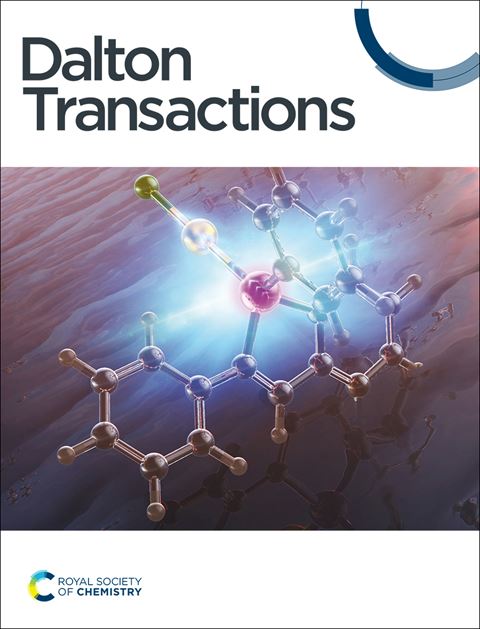A Bioinspired Model for Copper Monooxygenase: A Direct Aromatic Hydroxylation Using O2
IF 3.5
3区 化学
Q2 CHEMISTRY, INORGANIC & NUCLEAR
引用次数: 0
Abstract
A novel copper(I) complex, [CuI(L)(CH3CN)]CF3SO3 (1) (L = 1,1,2-tri(pyridin-2-yl)propan-1-ol), has been synthesized, characterized, and investigated as a bioinspired model for copper monooxygenases. Under aerobic conditions in CH3CN, complex 1 undergoes conversion to a dicopper complex, [(CuIIL)(CuIIL H)(SO3CF3)2]·CF3SO3·H2O (2), whose molecular structure reveals a Cu-Cu distance of 2.96 Å. A dicopper(II) complex, [(LCuII)2(SO3CF3)2] (3), has been synthesized for comparison, which exhibits a similar Cu-Cu distance of 2.97 Å. EPR spectroscopy has ascertained the solution state geometries of complexes 2 and 3, which displayed g׀׀ > g┴ values, indicative of distorted square pyramidal geometries consistent with their solid-state structures. Complex 1 selectively hydroxylates benzene in the presence of O₂ and Et₃N, affording 7% phenol based on the substrate, without any side products. However, the use of H2O2 as the oxygen source under identical conditions significantly increases the phenol yield to 19%. The catalytically active intermediates have been generated by the reaction of complex 1 with dioxygen showed an O (π*σ) → Cu ligand-to-metal charge transfer (LMCT) transition at 360 nm and a d-d transition at 650 nm. These spectral features are more pronounced with H2O2, showed a new LMCT transition at 360 nm and a very weak d-d transition at 689 nm. It is supported by solution FT-IR spectroscopy, which showed an O-O stretching frequency at 890 cm⁻¹ (DFT spectra at 829 cm⁻¹) corresponds to Cu-OOH intermediate. The structure of the [(L)CuII-OOH]+ species was optimized by DFT calculations. Kinetic isotope effect (KIE) studies using C6H6/C6D6 (1:1) (kH/kD = 1.03) and isotopic labeling experiments using H218O2 support our proposed mechanism of benzene hydroxylation. In contrast, dinuclear complexes 2 and 3 exhibited poor benzene hydroxylation activity even with H2O2 and yielded only 4% and 6% of phenol, respectively, along with by-products such as biphenyl and quinone under identical conditions.铜单氧酶的生物启发模型:使用 O2 的直接芳香烃羟化反应
合成了一种新型铜(I)配合物[CuI(L)(CH3CN)]CF3SO3 (1) (L = 1,1,2-三(吡啶-2-基)丙烷-1-醇),并对其进行了表征和研究,作为铜单加氧酶的仿生模型。在CH3CN的好氧条件下,配合物1转化为diccopper配合物[(CuIIL)(CuIIL H)(SO3CF3)2]·CF3SO3·H2O(2),其分子结构显示Cu-Cu距离为2.96 Å。合成了一种铜(II)配合物[(LCuII)2(SO3CF3)2](3)进行比较,其Cu-Cu距离相近,为2.97 Å。EPR光谱确定了配合物2和3的溶液态几何形状,它们表现为g / / /;G值,表明扭曲的方形金字塔几何形状与它们的固态结构一致。配合物1在O₂和Et₃N的存在下选择性地羟基化苯,在底物上产生7%的苯酚,没有任何副产物。而在相同条件下,以H2O2为氧源,苯酚收率显著提高至19%。配合物1与二氧反应生成的催化活性中间体在360 nm处呈现O (π*σ)→Cu配体到金属的电荷转移(LMCT)跃迁,在650 nm处呈现d-d跃迁。这些光谱特征在H2O2中更为明显,在360 nm处出现了新的LMCT跃迁,在689 nm处出现了非常弱的d-d跃迁。溶液FT-IR光谱结果表明,O-O的延伸频率为890 cm⁻¹(DFT光谱为829 cm⁻¹),与Cu-OOH中间体相对应。通过DFT计算优化了[(L)CuII-OOH]+的结构。用C6H6/C6D6 (1:1) (kH/kD = 1.03)进行的动力学同位素效应(KIE)研究和用H218O2进行的同位素标记实验支持了我们提出的苯羟基化机制。相比之下,双核配合物2和3即使在H2O2下也表现出较差的苯羟基化活性,在相同的条件下分别只产生4%和6%的苯酚,以及联苯和醌等副产物。
本文章由计算机程序翻译,如有差异,请以英文原文为准。
求助全文
约1分钟内获得全文
求助全文
来源期刊

Dalton Transactions
化学-无机化学与核化学
CiteScore
6.60
自引率
7.50%
发文量
1832
审稿时长
1.5 months
期刊介绍:
Dalton Transactions is a journal for all areas of inorganic chemistry, which encompasses the organometallic, bioinorganic and materials chemistry of the elements, with applications including synthesis, catalysis, energy conversion/storage, electrical devices and medicine. Dalton Transactions welcomes high-quality, original submissions in all of these areas and more, where the advancement of knowledge in inorganic chemistry is significant.
 求助内容:
求助内容: 应助结果提醒方式:
应助结果提醒方式:


